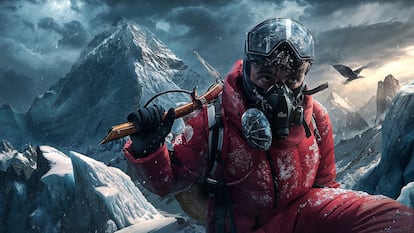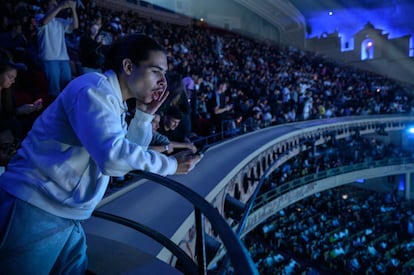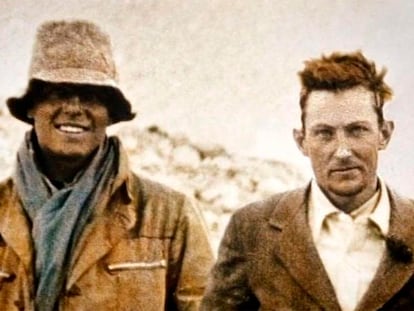The story of the YouTuber who climbed Everest and divided French society
Inoxtag, a 22-year-old who lived his life online before announcing he would attempt the world’s highest peak, has garnered more than 34 million views with a documentary that covers his journey to the summit

A year and a half ago, Inoxtag was just a YouTuber followed by a legion of 7 million gamers… until he announced that he would climb Everest with just 12 months of training and without having the slightest idea of what a mountain looked like. His announcement shook the networks and like a trail of burning gunpowder, it ran through their arteries to find its way into the epicenter of French gossip.
There is no middle ground: some hate him, others adore him. If you cross the Spanish border in the Basque town of Irún and visit a café in Hendaye, on the French side, all the locals know Inoxtag, a 22-year-old whose real name is Inès Benazzouz. “It’s incredible what he has done,” smiles the waiter. “You mean it’s incredible what the guides and the Sherpas have done, right? He has only proven that anyone can climb Everest if you’ve got the money,” retorts a patron. And then a debate breaks out in the bar, in which it is impossible to reach any kind of consensus. Hateful or not. Fake or not. Egotistical or not. Mountaineer or gifted amateur... the fact is that Inoxtag recently released a documentary on Youtube and it already has more than 35 million views, despite its almost 2.5 hours duration, a tough test of concentration for his young followers accustomed to fast-consumption products and video-clip formats.

Daniel, a 13-year-old Parisian, climbed Mont Blanc this summer with his father and a guide. Before the appointment in Chamonix, he had barely climbed any mountains, had never used crampons, and the snow he knew was that of ski resorts, but he says “Inoxtag’s example inspired me. It allowed me to discover the mountain, and now I love it. I dream of summits. It’s changed my life.”
Young people explain the overwhelming success of Inoxtag as a source of inspiration, a guiding light. The messages contained in the documentary, entitled Kaizen (which in Japanese translates as “continuous improvement”), are simple but also suspicious: you have to leave your room to discover the world; without pain there is no gain; the purification of the human condition through sport, dividing the world between those who are willing to put in the effort and those who are not… Along the way, it fails to point out that the planet is suffocating under the effects of climate change, say French environmental associations.
Mountaineers are amazed by the tremendous impact of the documentary. They do not understand that what they know as something normalized is the object of such passion among young people. Some, like the great mountain photographer Pascal Tournaire, or the famous mountaineer and former Everest speed record holder Marc Batard, shake their heads in horror and wonder what merit there is is in climbing a mountain that has been reduced to a mere commercial matter. To climb Everest, they say, all you need is money. Kaizen cost €1.2 million ($1.31 million) to produce, but its sponsors are rubbing their hands with glee at the return. Even YouTube’s executives are amazed. In France, on September 13 and 14, over 300,000 spectators paid to see a documentary in cinemas across the country that they could have watched for free the following day. On October 8, the French channel TF1 aired it.
The footage shows Inoxtag’s evolution from his life in front of the computer in his room to his discovery of the natural environment and his mountaineering achievements. Aside from his vast number of followers, Inoxtag is a product of his time: sedentary, cloistered within four walls, and living his life through screens. Perhaps the most authentic moment in the documentary features his mother, who, without showing her face to the camera, sighs in relief: “He has finally understood that life is not lived in front of a screen.” Sport, and in this case the mountain, with its echoes of adventure, seem to come to the rescue of a guy bored and stressed by his job. It’s a familiar story and at times you feel like you’re watching a Rocky movie. Here, Everest is the opponent to overcome, and while Sylvester Stallone guzzled raw eggs, Inoxtag learns to eat healthily. And while Stallone ran through grimy Philadelphia streets, Inoxtag runs through immaculate hillsides dressed in Nike; Rocky was knocked to the canvas before getting up; Inoxtag nearly doesn’t make the summit, but eventually triumphs.
Inoxtag’s ethical codes come from the manga he has devoured since he was a child and have nothing to do with the ethics defended by elite mountaineers. And although the influencer denounces the trash left behind at high-altitude camps, the theft of oxygen tanks, or the abandonment of mountaineers in trouble, he seems to want to say that all these miseries are small inconveniences to deal with on the way to the summit; the only thing that really matters. Tears and epic music liven up the backdrop to the message: you will be a better person because you have embraced a difficult, manly, and dangerous challenge, because you have surpassed yourself.
There is also a contradiction in the mountain journey of a novice like Inoxtag. His guide, Mathis Dumas, follows the standard training program point by point: use of tools, understanding of the environment, logical progression and the values of mountaineering, but ultimately ends up creating an egotistical being incapable of assuming principles such as learning through renunciation or humility. And, finally, a well-known reality is reinforced: if you have the best technical and human resources at your disposal, you will reach the top of Everest. Or any summit. On the other hand, the structure of the film is reminiscent of the Netflix documentary 14 Peaks: Nothing is Impossible, which covers the journey of the Nepalese climber Nirmal Purja in the Himalayas, before his fall from grace due to accusations of sexual harassment.
YouTube has become the perfect home for stories of all kinds. On October 6, the highly anticipated documentary about Klaas Willems, a climber with cystic fibrosis who relates his struggle to remain alive, was released on the platform. It will hardly match the success of Kaizen, whose effect on its young fans remains a mystery. As I leave the bar in Hendaye, the customers are still arguing irremediably.
Sign up for our weekly newsletter to get more English-language news coverage from EL PAÍS USA Edition
Tu suscripción se está usando en otro dispositivo
¿Quieres añadir otro usuario a tu suscripción?
Si continúas leyendo en este dispositivo, no se podrá leer en el otro.
FlechaTu suscripción se está usando en otro dispositivo y solo puedes acceder a EL PAÍS desde un dispositivo a la vez.
Si quieres compartir tu cuenta, cambia tu suscripción a la modalidad Premium, así podrás añadir otro usuario. Cada uno accederá con su propia cuenta de email, lo que os permitirá personalizar vuestra experiencia en EL PAÍS.
¿Tienes una suscripción de empresa? Accede aquí para contratar más cuentas.
En el caso de no saber quién está usando tu cuenta, te recomendamos cambiar tu contraseña aquí.
Si decides continuar compartiendo tu cuenta, este mensaje se mostrará en tu dispositivo y en el de la otra persona que está usando tu cuenta de forma indefinida, afectando a tu experiencia de lectura. Puedes consultar aquí los términos y condiciones de la suscripción digital.
More information
Archived In
Últimas noticias
Welcome to the post-religion era: The idea of Christianity as the absolute truth has become obsolete
‘I thought you would like it’: The risky sexual practice popularized by TV shows and TikTok
The digitalization of tourism: ‘They promise experiences and gave us the worst possible one’
Mexican peso defies uncertainty with forecasts of a new period of stability in 2026
Most viewed
- Sinaloa Cartel war is taking its toll on Los Chapitos
- Reinhard Genzel, Nobel laureate in physics: ‘One-minute videos will never give you the truth’
- Oona Chaplin: ‘I told James Cameron that I was living in a treehouse and starting a permaculture project with a friend’
- Why the price of coffee has skyrocketed: from Brazilian plantations to specialty coffee houses
- Silver prices are going crazy: This is what’s fueling the rally










































